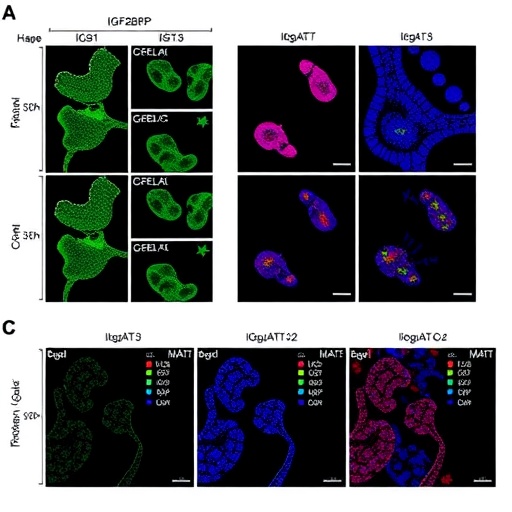In an illuminating advancement for the field of molecular biology and oncology, a recent study led by researchers Kim, N., Kim, M., Jeong, E., and their team has unveiled groundbreaking findings regarding the intricate mechanisms of DNA damage repair following ultraviolet (UV) radiation exposure. Published in the esteemed journal Cell Death Discovery, the study elucidates the critical roles of two previously underappreciated proteins, DEK and NUMA1, in orchestrating cellular responses to UV-induced DNA lesions. This discovery not only enriches our understanding of cellular defense systems but also opens promising avenues for therapeutic interventions targeting DNA repair pathways, particularly in cancer treatment strategies.
The fundamental biological process of DNA repair is pivotal to maintaining genomic integrity in all living organisms. UV radiation from sunlight is a major environmental mutagen that induces a spectrum of DNA damages, including cyclobutane pyrimidine dimers and 6-4 photoproducts, which, if left unrepaired, can lead to mutagenesis and carcinogenesis. Cells have evolved sophisticated networks, including nucleotide excision repair (NER), to detect and rectify such damage with high fidelity. However, the full complement of proteins involved in these pathways remains incompletely characterized, motivating researchers to undertake proteomic analyses to map the protein landscape activated by UV stress.
The study employed a state-of-the-art proteomic profiling approach to systematically identify protein candidates involved in the UV-induced DNA damage response. Utilizing tandem mass spectrometry integrated with advanced bioinformatics pipelines, the researchers analyzed the proteome of human cells subjected to controlled UV irradiation. This comprehensive analysis led to the intriguing identification of DEK and NUMA1 as significantly enriched proteins associated with the DNA damage repair machinery. Prior to this, these proteins were primarily recognized for their roles in chromatin remodeling and nuclear architecture, respectively, but their involvement in DNA repair had been speculative.
DEK, a chromatin-binding protein, emerged as a high-confidence interactor with repair complexes following UV exposure. Its well-documented function in modulating chromatin structure suggested a potential facilitative role in granting repair factors access to damaged DNA sites. Subsequent experimental validation confirmed that DEK is rapidly recruited to UV-damaged chromatin regions, where it appears to stabilize the repair complex assembly, thereby enhancing repair efficiency. This finding represents a paradigm shift, implicating DEK as a key regulator that bridges chromatin dynamics with DNA repair processes.
Concurrently, NUMA1, traditionally known for its contribution to mitotic spindle organization and nuclear matrix integrity, was also found to be mobilized upon UV irradiation. The researchers delineated a novel function of NUMA1 in anchoring repair proteins at sites of damage, effectively acting as a scaffold within the nuclear environment. Intriguingly, the loss of NUMA1 function in knockdown experiments led to markedly reduced repair kinetics and increased cellular sensitivity to UV-induced damage, providing compelling evidence of its critical role in maintaining genomic stability.
The mechanistic insights gained reveal a cooperative model wherein DEK and NUMA1 orchestrate a dynamic repair hub. DEK modulates chromatin accessibility, allowing repair machineries to engage DNA lesions, whereas NUMA1 organizes and stabilizes these complexes within the nucleus. This complementary action ensures a robust and timely response to UV-induced DNA insults, minimizing mutation accrual and preserving cellular viability. The study thereby highlights a sophisticated interplay between chromatin architecture modifications and spatial nuclear organization in DNA repair pathways.
Moreover, the implications of this discovery extend beyond fundamental biology, touching on cancer biology and therapeutic development. UV-induced mutations are a known driver of skin cancers such as melanoma and squamous cell carcinoma. Understanding the molecular underpinning of how cells cope with UV damage can inform strategies to enhance repair in normal cells or conversely, impair repair in cancer cells to potentiate treatments. Given that DEK and NUMA1 are differentially expressed in various cancer types, their modulation could present novel therapeutic targets to elevate DNA repair fidelity or sensitize tumors to genotoxic therapies.
The research incorporated a battery of experimental methods including co-immunoprecipitation assays, chromatin immunoprecipitation sequencing (ChIP-seq), and live-cell imaging to track the temporal and spatial dynamics of protein recruitment. This multipronged approach not only validated the proteomic identifications but also mapped the interaction networks and chromatin associations of DEK and NUMA1. The methodologies underscore the power of integrative cellular and molecular biology techniques in decoding complex intracellular responses to environmental damage.
Future directions stemming from this work are vast and impactful. Deepening the understanding of the regulatory modifications that govern DEK and NUMA1 function, such as post-translational modifications or interaction with other nuclear factors, will be crucial. Additionally, exploring whether these proteins influence repair pathways beyond NER, such as base excision repair or homologous recombination, could further elaborate their roles. Investigating the impact of their dysfunction in clinical samples from UV-related cancers may also yield biomarkers for prognosis or therapeutic response.
The study marks a significant step forward in the intricate map of DNA repair, unraveling previously unrecognized players that ensure cellular resilience in the face of genotoxic stress. As UV radiation remains a ubiquitous environmental hazard, delineating the multifaceted defense mechanisms is essential for developing preventative and interventional paradigms in medicine. The identification of DEK and NUMA1 as integral components enriches this narrative and challenges the research community to revise existing models of nuclear repair architecture.
In summary, the proteomic discovery of DEK and NUMA1 as key facilitators in UV-induced DNA damage repair represents a milestone achievement that enhances our molecular understanding and could catalyze future innovations in cancer biology and therapeutic development. The complementary roles of these proteins in chromatin remodeling and nuclear scaffolding exemplify the complexity and elegance of cellular protective mechanisms against environmental insults. This work underscores the transformative potential of proteomics and integrative molecular approaches in redefining biological pathways with direct clinical relevance.
Researchers and clinicians alike will find this study instructive as it expands the conceptual framework of DNA repair and underscores the intricate interplay between nuclear structure and genomic maintenance. Its profound implications may eventually translate into novel strategies to bolster cellular defenses or target malignancies with precision, marking it as a cornerstone contribution to the field of molecular medicine.
The comprehensive elucidation of DEK and NUMA1’s roles invites a broader reassessment of how nuclear organization influences DNA repair fidelity and cellular stress responses. This knowledge will inspire new research questions aimed at uncovering additional molecular players and mechanisms that safeguard our genome, ultimately contributing to improved human health outcomes in the face of environmental challenges.
As we continue to uncover the many facets of cellular repair machinery, studies such as this demonstrate the power of technological innovation in proteomics and live-cell imaging to reveal the previously unseen. The dynamic interplay between proteins inside the nucleus unfolds as an elaborate choreography, with DEK and NUMA1 taking center stage in maintaining genomic integrity under UV stress—a discovery that resonates deeply across multiple scientific disciplines.
Subject of Research: UV-induced DNA damage repair mechanisms and the role of DEK and NUMA1 proteins
Article Title: Proteomic discovery of DEK and NUMA1 as new players in UV-induced DNA damage repair mechanisms
Article References:
Kim, N., Kim, M., Jeong, E. et al. Proteomic discovery of DEK and NUMA1 as new players in UV-induced DNA damage repair mechanisms. Cell Death Discov. 11, 547 (2025). https://doi.org/10.1038/s41420-025-02823-z
Image Credits: AI Generated
DOI: 24 November 2025
Tags: advancements in molecular biology and oncologycancer treatment strategies targeting DNA repaircellular defense systems against UV radiationgenomic integrity and UV exposuremechanisms of mutagenesis and carcinogenesisnucleotide excision repair pathwaysproteomic analysis of UV-induced stressproteomic discovery in DNA repairroles of DEK and NUMA1 in UV responsetherapeutic interventions for DNA repairunderstanding protein interactions in DNA repairUV radiation and DNA damage mechanisms





